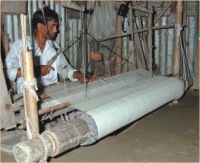textile timelines…
khadi and the guho family
IN
1921-22 Mahatma Gandhi and his followers were on a mission for peace
and patriotism. Their approach was simple, as was their choice of
attire. They embraced the rough textures of the spun cotton material
known as khadi.
 In
our country Shoilen Guho is considered as the pioneer of the khadi
creations and was known as Khadibabu. During his school days
in Chittagong he took a deep interest in the creation of this material.
The carpus cotton of Rangamati was spun into fibre for all
kinds of ropes, strings and fishing nets. At that time one of the
landlord's sons came back from abroad and set up a weaving factory.
Shoilen Guho learnt the rest of his trade at the factory.
In
our country Shoilen Guho is considered as the pioneer of the khadi
creations and was known as Khadibabu. During his school days
in Chittagong he took a deep interest in the creation of this material.
The carpus cotton of Rangamati was spun into fibre for all
kinds of ropes, strings and fishing nets. At that time one of the
landlord's sons came back from abroad and set up a weaving factory.
Shoilen Guho learnt the rest of his trade at the factory.
The
cotton needed to be soaked overnight and later would be treated with
starch before being put on the loom. Around 1931, during his teen
years, khadi was a very popular material. Shoilen was so
into the craft that he used to gather the thread from surrounding
villages and spin and sell his own cloth. At the same time he used
to work at the Chittagong National Textile Mill as the dyeing master.
What he learnt there regarding the coloring of cloth served as an
invaluable experience later on.
Abhoy
Asram in Chandinath, Comilla was a centre for spinning yarn. Warda
cotton was used for this purpose, resulting in a much better product.
Shoilen spent a lot of time there to create and promote khadi
as well as to educate and train the locals in the art of spinning.
His business expanded, as there was a boom in the demand, and he started
supplying his products to Calcutta. It reached a high with a conference
featuring the textile, which was directed by Shoilen.
 Despite
the popularity, the hand-cut material could not catch on in the market
at the time. Shoilen died in 1995 continuing his undying love for
the simple clothing material. He implored everyone to at least purchase
one sari, panjabi or dhuti made of khadi every year. He felt that
it was necessary to protect the heritage.
Despite
the popularity, the hand-cut material could not catch on in the market
at the time. Shoilen died in 1995 continuing his undying love for
the simple clothing material. He implored everyone to at least purchase
one sari, panjabi or dhuti made of khadi every year. He felt that
it was necessary to protect the heritage.
Shoilen had three
sons and two daughters. The elder sons worked with the father while
Arun, the youngest, studied mechanical engineering in Calcutta. His
first work experience took place in Kumudini related to dyeing and
block printing. He worked with his father later on to supply materials
when Aarong was established. Some time before and after Shoilen's
death famed fashion designer Bibi Russel had a hand in promoting khadi.
With her help and Shoilen's creative usage of colours and quality
control, the rural clothing item has achieved international recognition.
At the same time it has provided employment for countless artisans.
Rebirth
In the 50's khadi had risen high in the Indian market due to intense
promotion. The quality improved greatly with government aid and a
lot of effort on the personal level. Comparatively that did not seem
to happen in our country. Shoilen and his fellow craftsmen produced
enough to meet the market demand but khadi could not take over the
market from the other cloths although it came to a lot of uses and
was inexpensive.
 The
following years of the Liberation War saw a rise in patriotic feelings.
Joblessness brought about many entrepreneurs and some of them started
promoting home made clothing with the aid of khadi. Ashraful Rahman
Faruq was one such youth who presented khadi as a fashionable ensemble.
He opened the first shop catering khadi goods at Malibagh in Dhaka.
The outlet was called Nipun and there was everything on offer from
blankets and napkins to panjabis and shawls. He did not rest at simply
creating the clothing materials but went further to add value by utilising
colouring, printing and block techniques. Thus, other shops displaying
khadi sprouted such as Champak, Kumudini, Joya etc. It was the birth
of a new country and what better way to join the jubilation than to
revel in the country's own product? With such a mindset, K S M Faruq
opened up Khadi Bitan near the Dhaka Science Laboratory, selling khadi
from Comilla.
The
following years of the Liberation War saw a rise in patriotic feelings.
Joblessness brought about many entrepreneurs and some of them started
promoting home made clothing with the aid of khadi. Ashraful Rahman
Faruq was one such youth who presented khadi as a fashionable ensemble.
He opened the first shop catering khadi goods at Malibagh in Dhaka.
The outlet was called Nipun and there was everything on offer from
blankets and napkins to panjabis and shawls. He did not rest at simply
creating the clothing materials but went further to add value by utilising
colouring, printing and block techniques. Thus, other shops displaying
khadi sprouted such as Champak, Kumudini, Joya etc. It was the birth
of a new country and what better way to join the jubilation than to
revel in the country's own product? With such a mindset, K S M Faruq
opened up Khadi Bitan near the Dhaka Science Laboratory, selling khadi
from Comilla.
The 80's saw a
revolution in the demand for khadi. Men could find everything from
winter jackets and scarves to summer outfits like panjabi. Aarong,
Kumudini and later Prabartana promoted khadi in a different light
as something desirable. They had their own designers along with their
own factories and craftsmen.
Prabartana has
been able to increase the demand for khadi with its unique offerings
throughout the past decade. They have used their own personnel, production
techniques and expertise to make khadi into a comfortable cotton fabric
fit for regular use.
 Bibi
Russel and khadi
Bibi
Russel and khadi
Internationally famed designer and model Bibi Russel came back to
Bangladesh in 1994 and started work on developing the local weaving
industry. She set her sights on the jamdani, muslin, check and khadi
centring the materials for a fashion development program. A lot of
the work revolved around Shoilen Guho's khadi products. The duo helped
to bring khadi further into the limelight during the mid-nineties.
Bibi arranged fashion show at home and abroad to increase the popularity
of khadi resulting in a significant following alongside Indian khadi.
Bibi commented
that people prefer to use natural and ecologically friendly materials
like khadi. She is endeavouring to further the work that Shoilen Guho
started and also trying to protect the Comilla khadi society. She
also said that nowadays, real khadi, whose threads used to be a little
thicker, is no longer prepared. It had its own elegance. At present
khadi is made with mixed fibres.
She also informed
that the fashion shows have been organised to promote khadi and these
will help the artisans. Unfortunately, this year the flooding has
almost brought the industry to a standstill. The financial hardships
have to be overcome by providing extra orders for the weavers.
 The
challenges
The
challenges
In the words of Gandhi, khadi is a fabric for human values and ethics.
It delivers the people from the bond of the rich and creates a spiritual
bond between the classes and the masses.
The creation of
khadi follows a certain rhythm for which even an old woman who cannot
see can sit and spin out the thread with utmost skill. A weaver can
use that thread to churn out 8-12 yards of material. In return they
get a stipend of 12 taka per yard. In cases where there are two designs
on one cloth then they pay charges accordingly. Most of the khadi
in the country is made from waste cotton. Now, the word 'waste' may
sound bad, but in reality it isn't. It's more of recycling. You see,
the textile mills discard a lot of cotton and this is used in turn
to spin a thick thread.
Khadi has a lot
of potential. In the past two years there has been a dramatic rise
in the demand with a wide range of clothing for both men and women
available in this material. The many different designers and boutiques
are in a race to create the most desirable ensemble. The thick khadi
thread is used to create different patterns incorporating modified
weaving techniques.
 Those
who are involved with khadi are also facing many difficulties. Arun
Guho, the country's primary khadi producer, explained that proper
cash inflow is needed to keep the industry on a winning streak. Many
times items are delivered on credit. Also the cotton required for
production is often unavailable according to demand. As a result the
workers have to make do with whatever is available. A continuous twelve-month
work period cannot be maintained. Thread made with pit loom and power
loom does not provide a good finish. Producers of khadi spend about
eight months using thread from textile mills and the other four months
using cotton threads. Despite the fact that some other producers are
doing well using foreign yarn Arun Guho wants to stick to using local
material.
Those
who are involved with khadi are also facing many difficulties. Arun
Guho, the country's primary khadi producer, explained that proper
cash inflow is needed to keep the industry on a winning streak. Many
times items are delivered on credit. Also the cotton required for
production is often unavailable according to demand. As a result the
workers have to make do with whatever is available. A continuous twelve-month
work period cannot be maintained. Thread made with pit loom and power
loom does not provide a good finish. Producers of khadi spend about
eight months using thread from textile mills and the other four months
using cotton threads. Despite the fact that some other producers are
doing well using foreign yarn Arun Guho wants to stick to using local
material.
 Shamim
Hossain, director of Prabartana, informed that the greater demand
of khadi comes from the middle class. Sales are good but not as much
as expected. One of the reasons is that good quality cotton is not
easily available. Without good cotton the weavers lose interest in
the work. Also there is the ongoing system of middlemen that just
exacerbates the condition.
Shamim
Hossain, director of Prabartana, informed that the greater demand
of khadi comes from the middle class. Sales are good but not as much
as expected. One of the reasons is that good quality cotton is not
easily available. Without good cotton the weavers lose interest in
the work. Also there is the ongoing system of middlemen that just
exacerbates the condition.
Khadi's acceptance
among the new generation is increasing. It is used not only for clothing
materials but also as part of home furnishing in the form of curtains,
bed sheets etc. Khadi is an old tradition and it only goes to show
that old is indeed gold.
By
Sultana Yasmin
Translated by Ehsanur Raza Ronny
Special thanks to Bibi Russel, Bibi Productions and
Shamim Hossain, Probartana, Model on the cover: Faika

